HNC/HND Business: Leadership, Management, and Tesco Case Study
VerifiedAdded on 2023/01/18
|9
|2767
|38
Report
AI Summary
This report delves into the core concepts of leadership and management, differentiating between the roles and characteristics of leaders and managers. It explores the application of leadership and management functions within various situational contexts, using Tesco as a case study to illustrate practical implementation. The report examines key leadership theories and models, including the Great Man theory, trait theory, contingency theory, situational theory, behavioral theory, and relationship theory. Additionally, it covers models like the authoritative leader, authentic executive, and forerunner executive. The analysis highlights how these theories and models can be applied to real-world business challenges and opportunities, providing a comprehensive overview of leadership and management principles. The report also discusses management functions like planning, organizing, staffing, directing, and controlling, and how these functions are crucial for business success. Finally, it offers insights into how leaders and managers can contribute to organizational growth and overcome challenges.
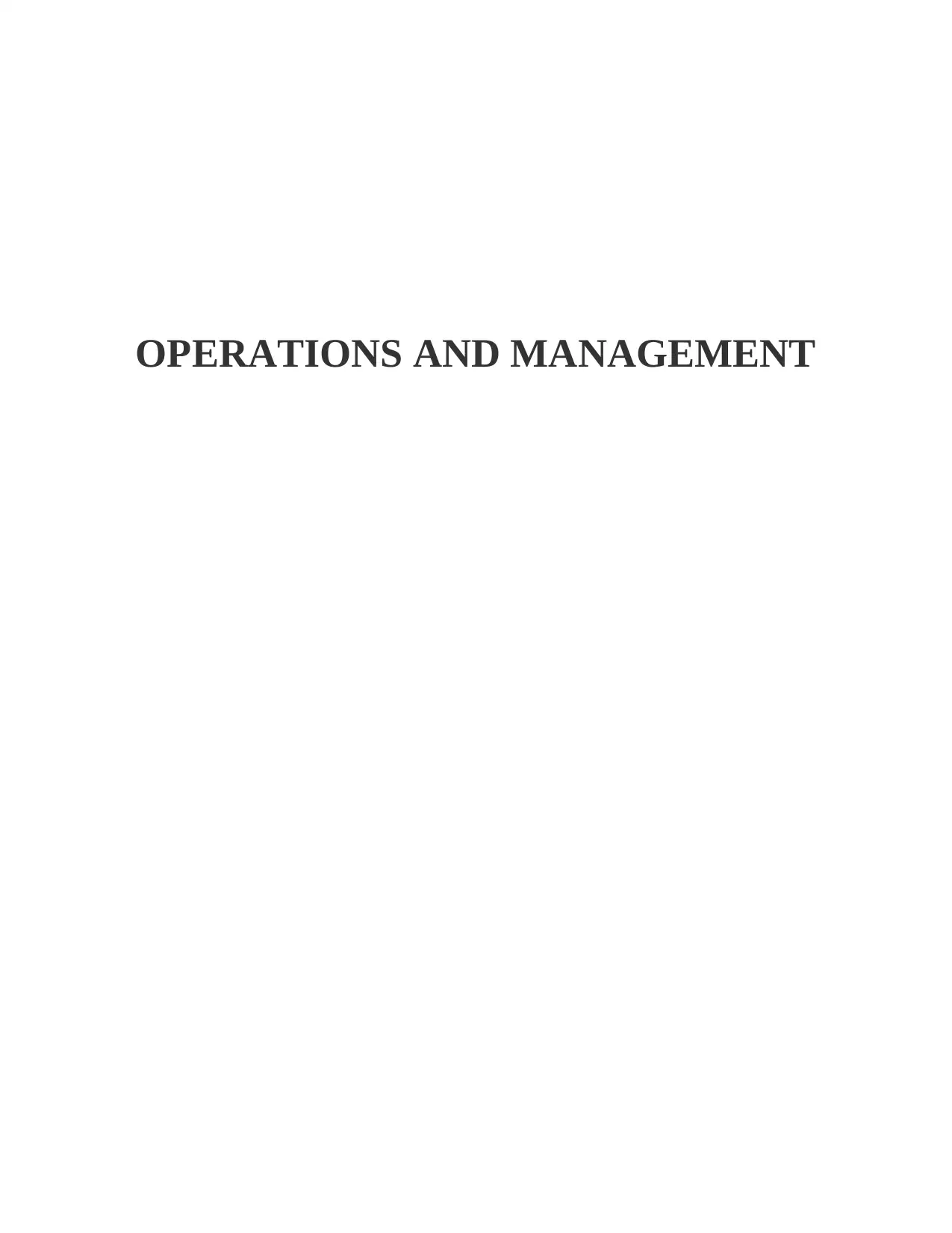
OPERATIONS AND MANAGEMENT
Paraphrase This Document
Need a fresh take? Get an instant paraphrase of this document with our AI Paraphraser
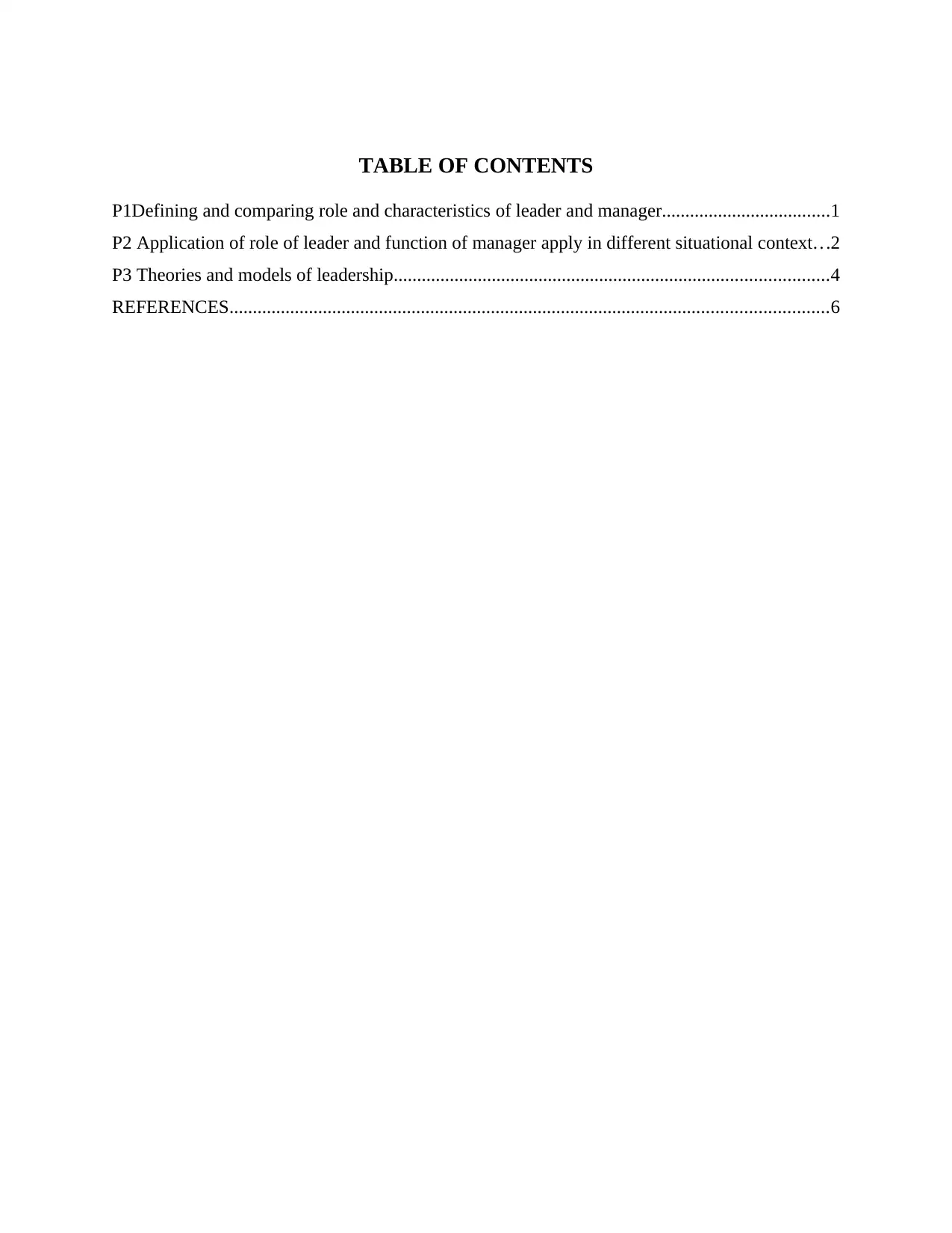
TABLE OF CONTENTS
P1Defining and comparing role and characteristics of leader and manager....................................1
P2 Application of role of leader and function of manager apply in different situational context.. .2
P3 Theories and models of leadership.............................................................................................4
REFERENCES................................................................................................................................6
P1Defining and comparing role and characteristics of leader and manager....................................1
P2 Application of role of leader and function of manager apply in different situational context.. .2
P3 Theories and models of leadership.............................................................................................4
REFERENCES................................................................................................................................6
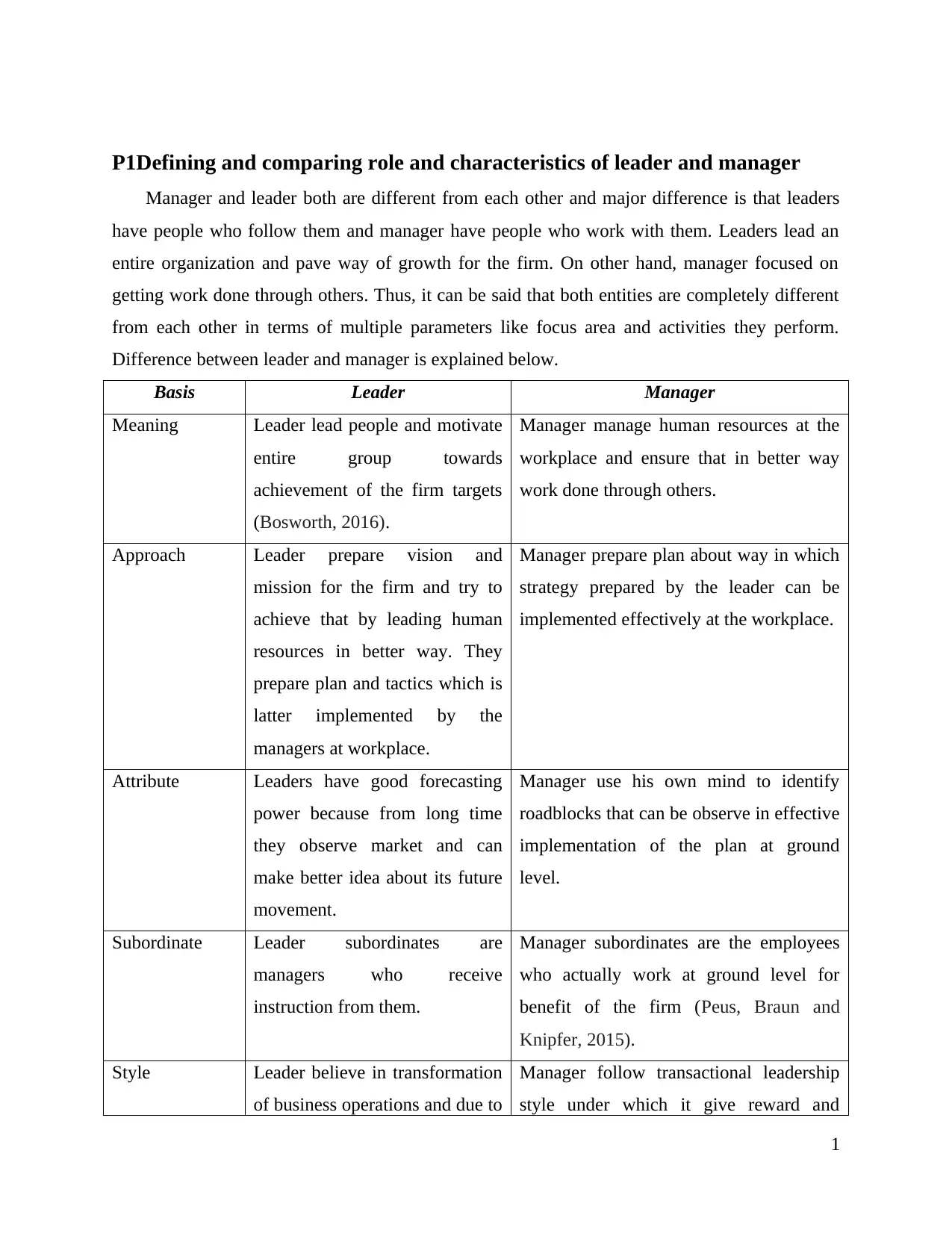
P1Defining and comparing role and characteristics of leader and manager
Manager and leader both are different from each other and major difference is that leaders
have people who follow them and manager have people who work with them. Leaders lead an
entire organization and pave way of growth for the firm. On other hand, manager focused on
getting work done through others. Thus, it can be said that both entities are completely different
from each other in terms of multiple parameters like focus area and activities they perform.
Difference between leader and manager is explained below.
Basis Leader Manager
Meaning Leader lead people and motivate
entire group towards
achievement of the firm targets
(Bosworth, 2016).
Manager manage human resources at the
workplace and ensure that in better way
work done through others.
Approach Leader prepare vision and
mission for the firm and try to
achieve that by leading human
resources in better way. They
prepare plan and tactics which is
latter implemented by the
managers at workplace.
Manager prepare plan about way in which
strategy prepared by the leader can be
implemented effectively at the workplace.
Attribute Leaders have good forecasting
power because from long time
they observe market and can
make better idea about its future
movement.
Manager use his own mind to identify
roadblocks that can be observe in effective
implementation of the plan at ground
level.
Subordinate Leader subordinates are
managers who receive
instruction from them.
Manager subordinates are the employees
who actually work at ground level for
benefit of the firm (Peus, Braun and
Knipfer, 2015).
Style Leader believe in transformation
of business operations and due to
Manager follow transactional leadership
style under which it give reward and
1
Manager and leader both are different from each other and major difference is that leaders
have people who follow them and manager have people who work with them. Leaders lead an
entire organization and pave way of growth for the firm. On other hand, manager focused on
getting work done through others. Thus, it can be said that both entities are completely different
from each other in terms of multiple parameters like focus area and activities they perform.
Difference between leader and manager is explained below.
Basis Leader Manager
Meaning Leader lead people and motivate
entire group towards
achievement of the firm targets
(Bosworth, 2016).
Manager manage human resources at the
workplace and ensure that in better way
work done through others.
Approach Leader prepare vision and
mission for the firm and try to
achieve that by leading human
resources in better way. They
prepare plan and tactics which is
latter implemented by the
managers at workplace.
Manager prepare plan about way in which
strategy prepared by the leader can be
implemented effectively at the workplace.
Attribute Leaders have good forecasting
power because from long time
they observe market and can
make better idea about its future
movement.
Manager use his own mind to identify
roadblocks that can be observe in effective
implementation of the plan at ground
level.
Subordinate Leader subordinates are
managers who receive
instruction from them.
Manager subordinates are the employees
who actually work at ground level for
benefit of the firm (Peus, Braun and
Knipfer, 2015).
Style Leader believe in transformation
of business operations and due to
Manager follow transactional leadership
style under which it give reward and
1
⊘ This is a preview!⊘
Do you want full access?
Subscribe today to unlock all pages.

Trusted by 1+ million students worldwide
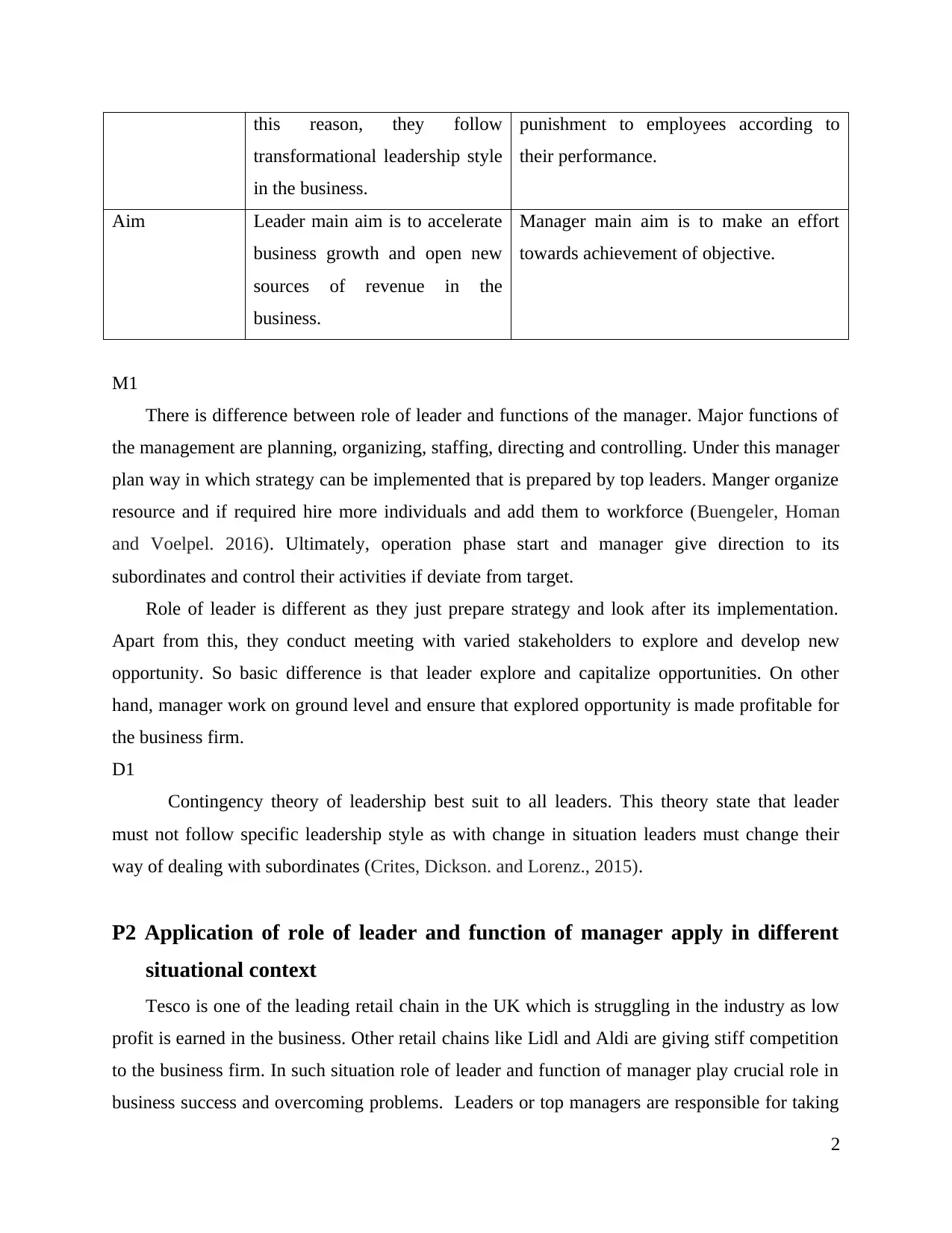
this reason, they follow
transformational leadership style
in the business.
punishment to employees according to
their performance.
Aim Leader main aim is to accelerate
business growth and open new
sources of revenue in the
business.
Manager main aim is to make an effort
towards achievement of objective.
M1
There is difference between role of leader and functions of the manager. Major functions of
the management are planning, organizing, staffing, directing and controlling. Under this manager
plan way in which strategy can be implemented that is prepared by top leaders. Manger organize
resource and if required hire more individuals and add them to workforce (Buengeler, Homan
and Voelpel. 2016). Ultimately, operation phase start and manager give direction to its
subordinates and control their activities if deviate from target.
Role of leader is different as they just prepare strategy and look after its implementation.
Apart from this, they conduct meeting with varied stakeholders to explore and develop new
opportunity. So basic difference is that leader explore and capitalize opportunities. On other
hand, manager work on ground level and ensure that explored opportunity is made profitable for
the business firm.
D1
Contingency theory of leadership best suit to all leaders. This theory state that leader
must not follow specific leadership style as with change in situation leaders must change their
way of dealing with subordinates (Crites, Dickson. and Lorenz., 2015).
P2 Application of role of leader and function of manager apply in different
situational context
Tesco is one of the leading retail chain in the UK which is struggling in the industry as low
profit is earned in the business. Other retail chains like Lidl and Aldi are giving stiff competition
to the business firm. In such situation role of leader and function of manager play crucial role in
business success and overcoming problems. Leaders or top managers are responsible for taking
2
transformational leadership style
in the business.
punishment to employees according to
their performance.
Aim Leader main aim is to accelerate
business growth and open new
sources of revenue in the
business.
Manager main aim is to make an effort
towards achievement of objective.
M1
There is difference between role of leader and functions of the manager. Major functions of
the management are planning, organizing, staffing, directing and controlling. Under this manager
plan way in which strategy can be implemented that is prepared by top leaders. Manger organize
resource and if required hire more individuals and add them to workforce (Buengeler, Homan
and Voelpel. 2016). Ultimately, operation phase start and manager give direction to its
subordinates and control their activities if deviate from target.
Role of leader is different as they just prepare strategy and look after its implementation.
Apart from this, they conduct meeting with varied stakeholders to explore and develop new
opportunity. So basic difference is that leader explore and capitalize opportunities. On other
hand, manager work on ground level and ensure that explored opportunity is made profitable for
the business firm.
D1
Contingency theory of leadership best suit to all leaders. This theory state that leader
must not follow specific leadership style as with change in situation leaders must change their
way of dealing with subordinates (Crites, Dickson. and Lorenz., 2015).
P2 Application of role of leader and function of manager apply in different
situational context
Tesco is one of the leading retail chain in the UK which is struggling in the industry as low
profit is earned in the business. Other retail chains like Lidl and Aldi are giving stiff competition
to the business firm. In such situation role of leader and function of manager play crucial role in
business success and overcoming problems. Leaders or top managers are responsible for taking
2
Paraphrase This Document
Need a fresh take? Get an instant paraphrase of this document with our AI Paraphraser
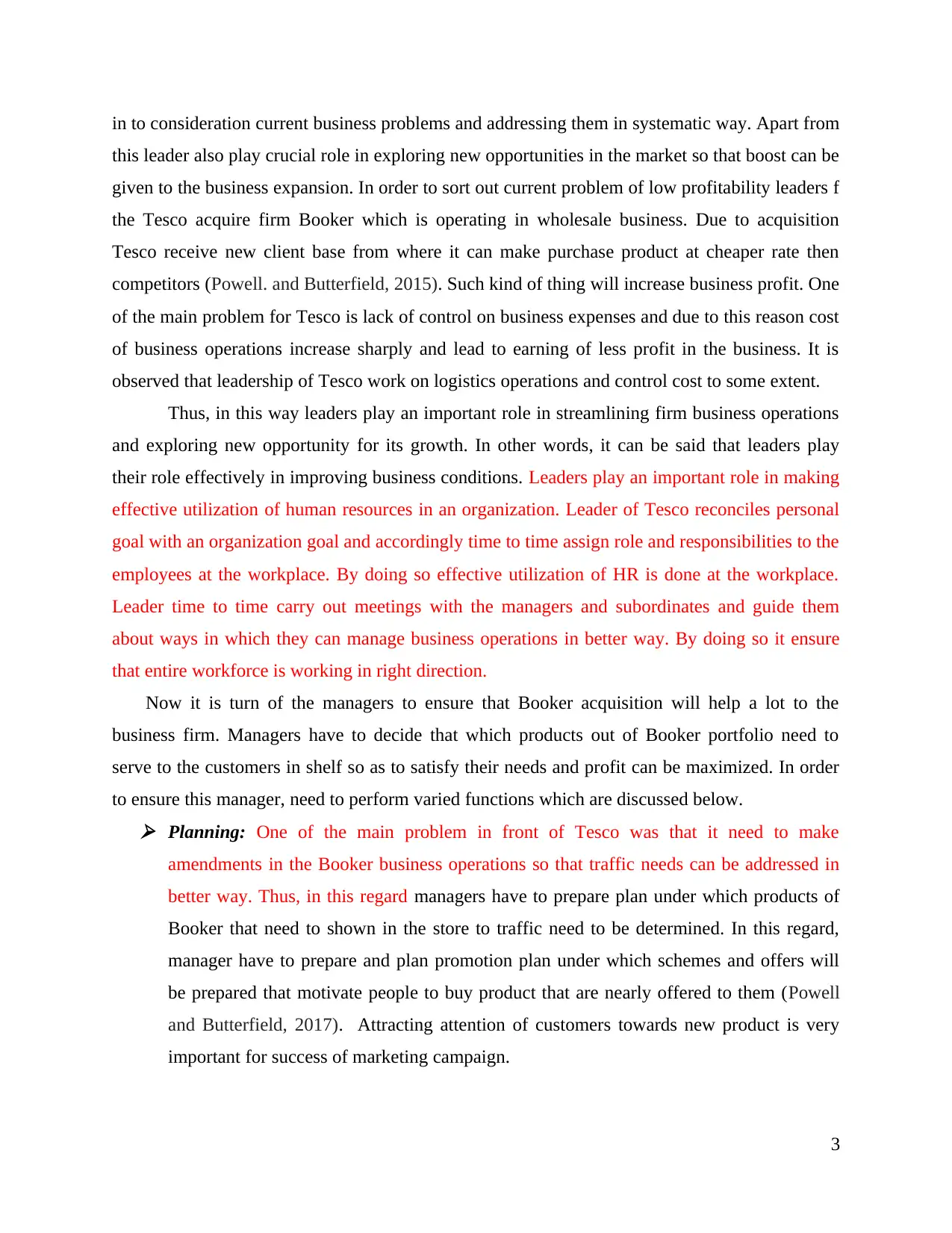
in to consideration current business problems and addressing them in systematic way. Apart from
this leader also play crucial role in exploring new opportunities in the market so that boost can be
given to the business expansion. In order to sort out current problem of low profitability leaders f
the Tesco acquire firm Booker which is operating in wholesale business. Due to acquisition
Tesco receive new client base from where it can make purchase product at cheaper rate then
competitors (Powell. and Butterfield, 2015). Such kind of thing will increase business profit. One
of the main problem for Tesco is lack of control on business expenses and due to this reason cost
of business operations increase sharply and lead to earning of less profit in the business. It is
observed that leadership of Tesco work on logistics operations and control cost to some extent.
Thus, in this way leaders play an important role in streamlining firm business operations
and exploring new opportunity for its growth. In other words, it can be said that leaders play
their role effectively in improving business conditions. Leaders play an important role in making
effective utilization of human resources in an organization. Leader of Tesco reconciles personal
goal with an organization goal and accordingly time to time assign role and responsibilities to the
employees at the workplace. By doing so effective utilization of HR is done at the workplace.
Leader time to time carry out meetings with the managers and subordinates and guide them
about ways in which they can manage business operations in better way. By doing so it ensure
that entire workforce is working in right direction.
Now it is turn of the managers to ensure that Booker acquisition will help a lot to the
business firm. Managers have to decide that which products out of Booker portfolio need to
serve to the customers in shelf so as to satisfy their needs and profit can be maximized. In order
to ensure this manager, need to perform varied functions which are discussed below. Planning: One of the main problem in front of Tesco was that it need to make
amendments in the Booker business operations so that traffic needs can be addressed in
better way. Thus, in this regard managers have to prepare plan under which products of
Booker that need to shown in the store to traffic need to be determined. In this regard,
manager have to prepare and plan promotion plan under which schemes and offers will
be prepared that motivate people to buy product that are nearly offered to them (Powell
and Butterfield, 2017). Attracting attention of customers towards new product is very
important for success of marketing campaign.
3
this leader also play crucial role in exploring new opportunities in the market so that boost can be
given to the business expansion. In order to sort out current problem of low profitability leaders f
the Tesco acquire firm Booker which is operating in wholesale business. Due to acquisition
Tesco receive new client base from where it can make purchase product at cheaper rate then
competitors (Powell. and Butterfield, 2015). Such kind of thing will increase business profit. One
of the main problem for Tesco is lack of control on business expenses and due to this reason cost
of business operations increase sharply and lead to earning of less profit in the business. It is
observed that leadership of Tesco work on logistics operations and control cost to some extent.
Thus, in this way leaders play an important role in streamlining firm business operations
and exploring new opportunity for its growth. In other words, it can be said that leaders play
their role effectively in improving business conditions. Leaders play an important role in making
effective utilization of human resources in an organization. Leader of Tesco reconciles personal
goal with an organization goal and accordingly time to time assign role and responsibilities to the
employees at the workplace. By doing so effective utilization of HR is done at the workplace.
Leader time to time carry out meetings with the managers and subordinates and guide them
about ways in which they can manage business operations in better way. By doing so it ensure
that entire workforce is working in right direction.
Now it is turn of the managers to ensure that Booker acquisition will help a lot to the
business firm. Managers have to decide that which products out of Booker portfolio need to
serve to the customers in shelf so as to satisfy their needs and profit can be maximized. In order
to ensure this manager, need to perform varied functions which are discussed below. Planning: One of the main problem in front of Tesco was that it need to make
amendments in the Booker business operations so that traffic needs can be addressed in
better way. Thus, in this regard managers have to prepare plan under which products of
Booker that need to shown in the store to traffic need to be determined. In this regard,
manager have to prepare and plan promotion plan under which schemes and offers will
be prepared that motivate people to buy product that are nearly offered to them (Powell
and Butterfield, 2017). Attracting attention of customers towards new product is very
important for success of marketing campaign.
3
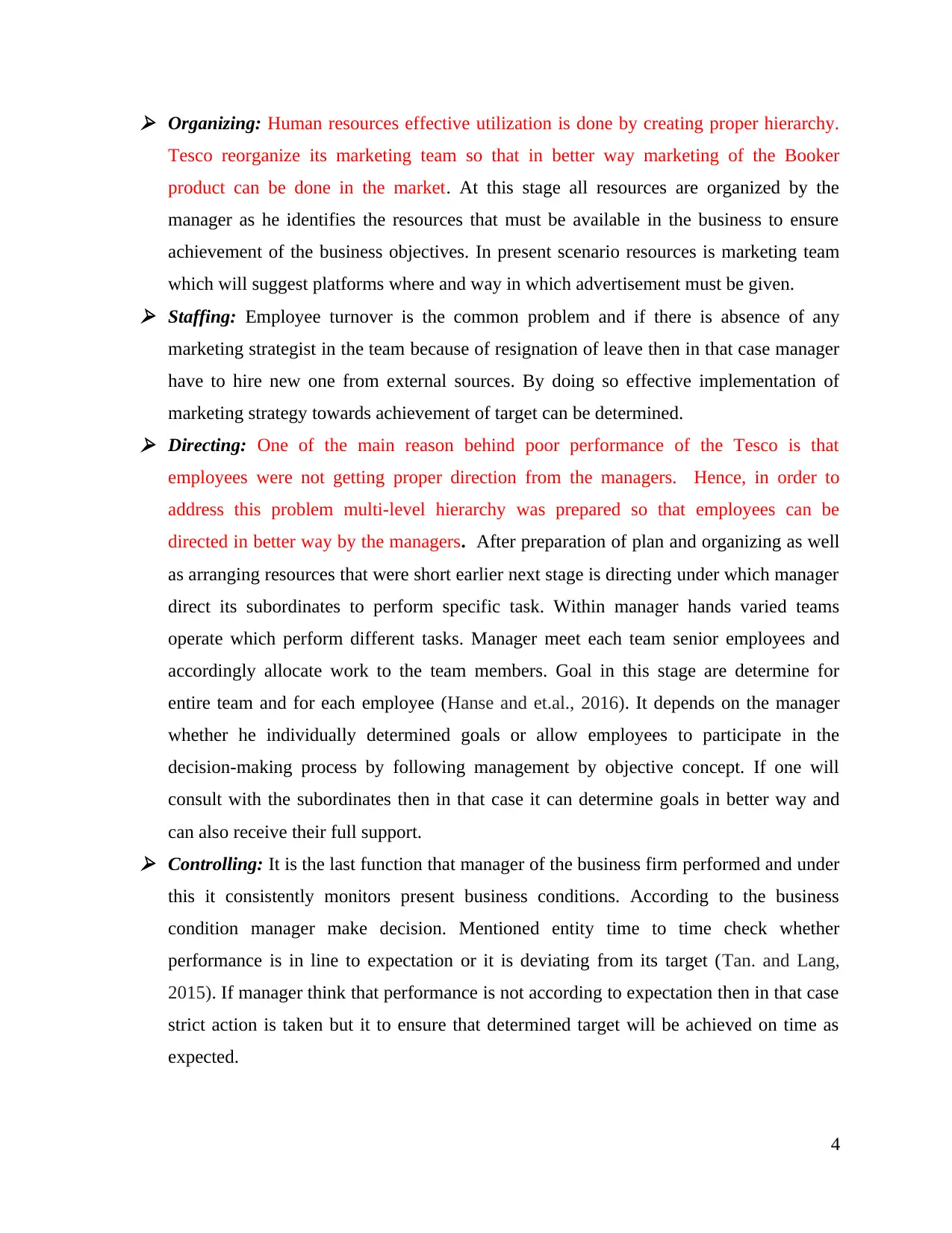
Organizing: Human resources effective utilization is done by creating proper hierarchy.
Tesco reorganize its marketing team so that in better way marketing of the Booker
product can be done in the market. At this stage all resources are organized by the
manager as he identifies the resources that must be available in the business to ensure
achievement of the business objectives. In present scenario resources is marketing team
which will suggest platforms where and way in which advertisement must be given. Staffing: Employee turnover is the common problem and if there is absence of any
marketing strategist in the team because of resignation of leave then in that case manager
have to hire new one from external sources. By doing so effective implementation of
marketing strategy towards achievement of target can be determined. Directing: One of the main reason behind poor performance of the Tesco is that
employees were not getting proper direction from the managers. Hence, in order to
address this problem multi-level hierarchy was prepared so that employees can be
directed in better way by the managers. After preparation of plan and organizing as well
as arranging resources that were short earlier next stage is directing under which manager
direct its subordinates to perform specific task. Within manager hands varied teams
operate which perform different tasks. Manager meet each team senior employees and
accordingly allocate work to the team members. Goal in this stage are determine for
entire team and for each employee (Hanse and et.al., 2016). It depends on the manager
whether he individually determined goals or allow employees to participate in the
decision-making process by following management by objective concept. If one will
consult with the subordinates then in that case it can determine goals in better way and
can also receive their full support. Controlling: It is the last function that manager of the business firm performed and under
this it consistently monitors present business conditions. According to the business
condition manager make decision. Mentioned entity time to time check whether
performance is in line to expectation or it is deviating from its target (Tan. and Lang,
2015). If manager think that performance is not according to expectation then in that case
strict action is taken but it to ensure that determined target will be achieved on time as
expected.
4
Tesco reorganize its marketing team so that in better way marketing of the Booker
product can be done in the market. At this stage all resources are organized by the
manager as he identifies the resources that must be available in the business to ensure
achievement of the business objectives. In present scenario resources is marketing team
which will suggest platforms where and way in which advertisement must be given. Staffing: Employee turnover is the common problem and if there is absence of any
marketing strategist in the team because of resignation of leave then in that case manager
have to hire new one from external sources. By doing so effective implementation of
marketing strategy towards achievement of target can be determined. Directing: One of the main reason behind poor performance of the Tesco is that
employees were not getting proper direction from the managers. Hence, in order to
address this problem multi-level hierarchy was prepared so that employees can be
directed in better way by the managers. After preparation of plan and organizing as well
as arranging resources that were short earlier next stage is directing under which manager
direct its subordinates to perform specific task. Within manager hands varied teams
operate which perform different tasks. Manager meet each team senior employees and
accordingly allocate work to the team members. Goal in this stage are determine for
entire team and for each employee (Hanse and et.al., 2016). It depends on the manager
whether he individually determined goals or allow employees to participate in the
decision-making process by following management by objective concept. If one will
consult with the subordinates then in that case it can determine goals in better way and
can also receive their full support. Controlling: It is the last function that manager of the business firm performed and under
this it consistently monitors present business conditions. According to the business
condition manager make decision. Mentioned entity time to time check whether
performance is in line to expectation or it is deviating from its target (Tan. and Lang,
2015). If manager think that performance is not according to expectation then in that case
strict action is taken but it to ensure that determined target will be achieved on time as
expected.
4
⊘ This is a preview!⊘
Do you want full access?
Subscribe today to unlock all pages.

Trusted by 1+ million students worldwide
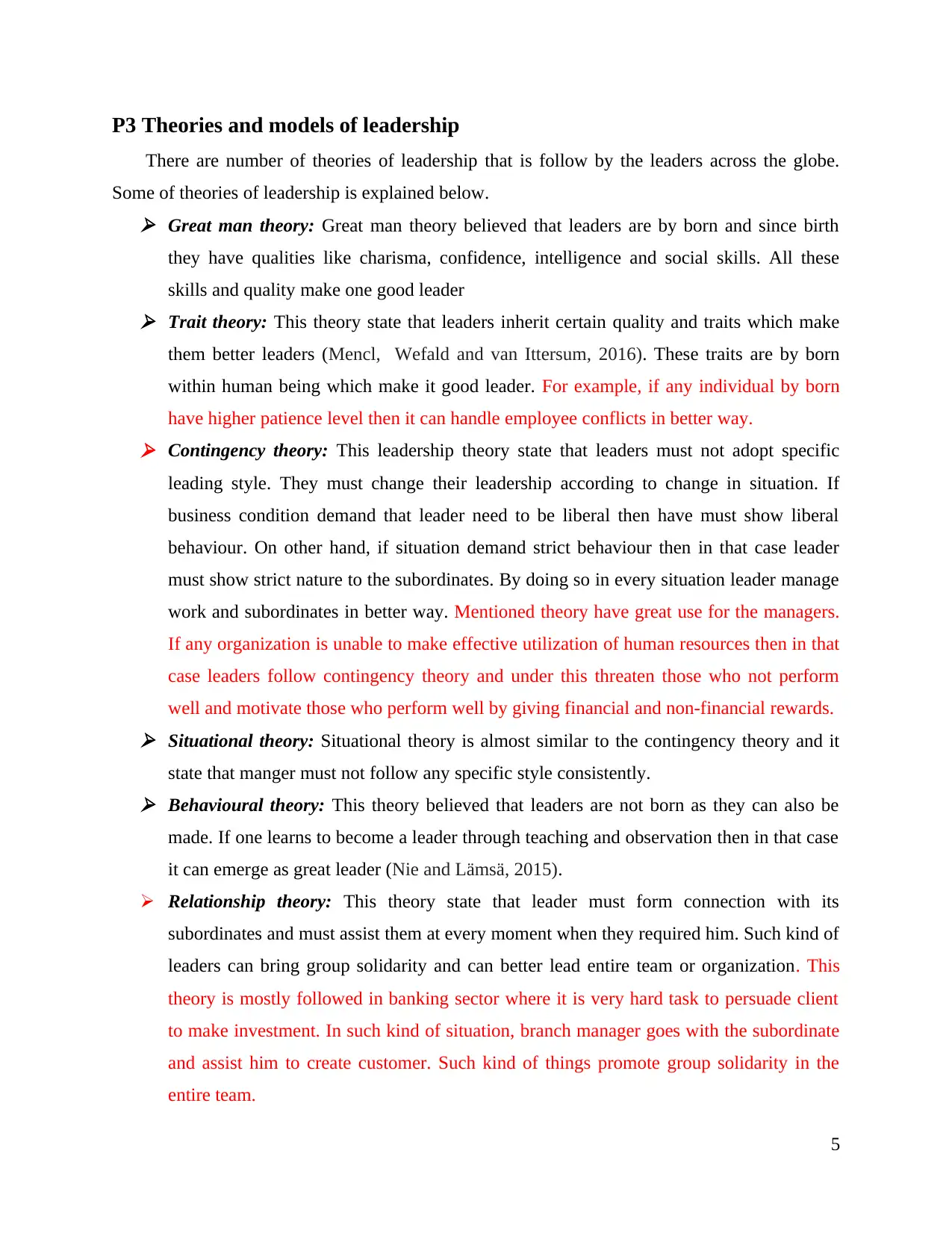
P3 Theories and models of leadership
There are number of theories of leadership that is follow by the leaders across the globe.
Some of theories of leadership is explained below. Great man theory: Great man theory believed that leaders are by born and since birth
they have qualities like charisma, confidence, intelligence and social skills. All these
skills and quality make one good leader Trait theory: This theory state that leaders inherit certain quality and traits which make
them better leaders (Mencl, Wefald and van Ittersum, 2016). These traits are by born
within human being which make it good leader. For example, if any individual by born
have higher patience level then it can handle employee conflicts in better way. Contingency theory: This leadership theory state that leaders must not adopt specific
leading style. They must change their leadership according to change in situation. If
business condition demand that leader need to be liberal then have must show liberal
behaviour. On other hand, if situation demand strict behaviour then in that case leader
must show strict nature to the subordinates. By doing so in every situation leader manage
work and subordinates in better way. Mentioned theory have great use for the managers.
If any organization is unable to make effective utilization of human resources then in that
case leaders follow contingency theory and under this threaten those who not perform
well and motivate those who perform well by giving financial and non-financial rewards. Situational theory: Situational theory is almost similar to the contingency theory and it
state that manger must not follow any specific style consistently. Behavioural theory: This theory believed that leaders are not born as they can also be
made. If one learns to become a leader through teaching and observation then in that case
it can emerge as great leader (Nie and Lämsä, 2015).
Relationship theory: This theory state that leader must form connection with its
subordinates and must assist them at every moment when they required him. Such kind of
leaders can bring group solidarity and can better lead entire team or organization. This
theory is mostly followed in banking sector where it is very hard task to persuade client
to make investment. In such kind of situation, branch manager goes with the subordinate
and assist him to create customer. Such kind of things promote group solidarity in the
entire team.
5
There are number of theories of leadership that is follow by the leaders across the globe.
Some of theories of leadership is explained below. Great man theory: Great man theory believed that leaders are by born and since birth
they have qualities like charisma, confidence, intelligence and social skills. All these
skills and quality make one good leader Trait theory: This theory state that leaders inherit certain quality and traits which make
them better leaders (Mencl, Wefald and van Ittersum, 2016). These traits are by born
within human being which make it good leader. For example, if any individual by born
have higher patience level then it can handle employee conflicts in better way. Contingency theory: This leadership theory state that leaders must not adopt specific
leading style. They must change their leadership according to change in situation. If
business condition demand that leader need to be liberal then have must show liberal
behaviour. On other hand, if situation demand strict behaviour then in that case leader
must show strict nature to the subordinates. By doing so in every situation leader manage
work and subordinates in better way. Mentioned theory have great use for the managers.
If any organization is unable to make effective utilization of human resources then in that
case leaders follow contingency theory and under this threaten those who not perform
well and motivate those who perform well by giving financial and non-financial rewards. Situational theory: Situational theory is almost similar to the contingency theory and it
state that manger must not follow any specific style consistently. Behavioural theory: This theory believed that leaders are not born as they can also be
made. If one learns to become a leader through teaching and observation then in that case
it can emerge as great leader (Nie and Lämsä, 2015).
Relationship theory: This theory state that leader must form connection with its
subordinates and must assist them at every moment when they required him. Such kind of
leaders can bring group solidarity and can better lead entire team or organization. This
theory is mostly followed in banking sector where it is very hard task to persuade client
to make investment. In such kind of situation, branch manager goes with the subordinate
and assist him to create customer. Such kind of things promote group solidarity in the
entire team.
5
Paraphrase This Document
Need a fresh take? Get an instant paraphrase of this document with our AI Paraphraser
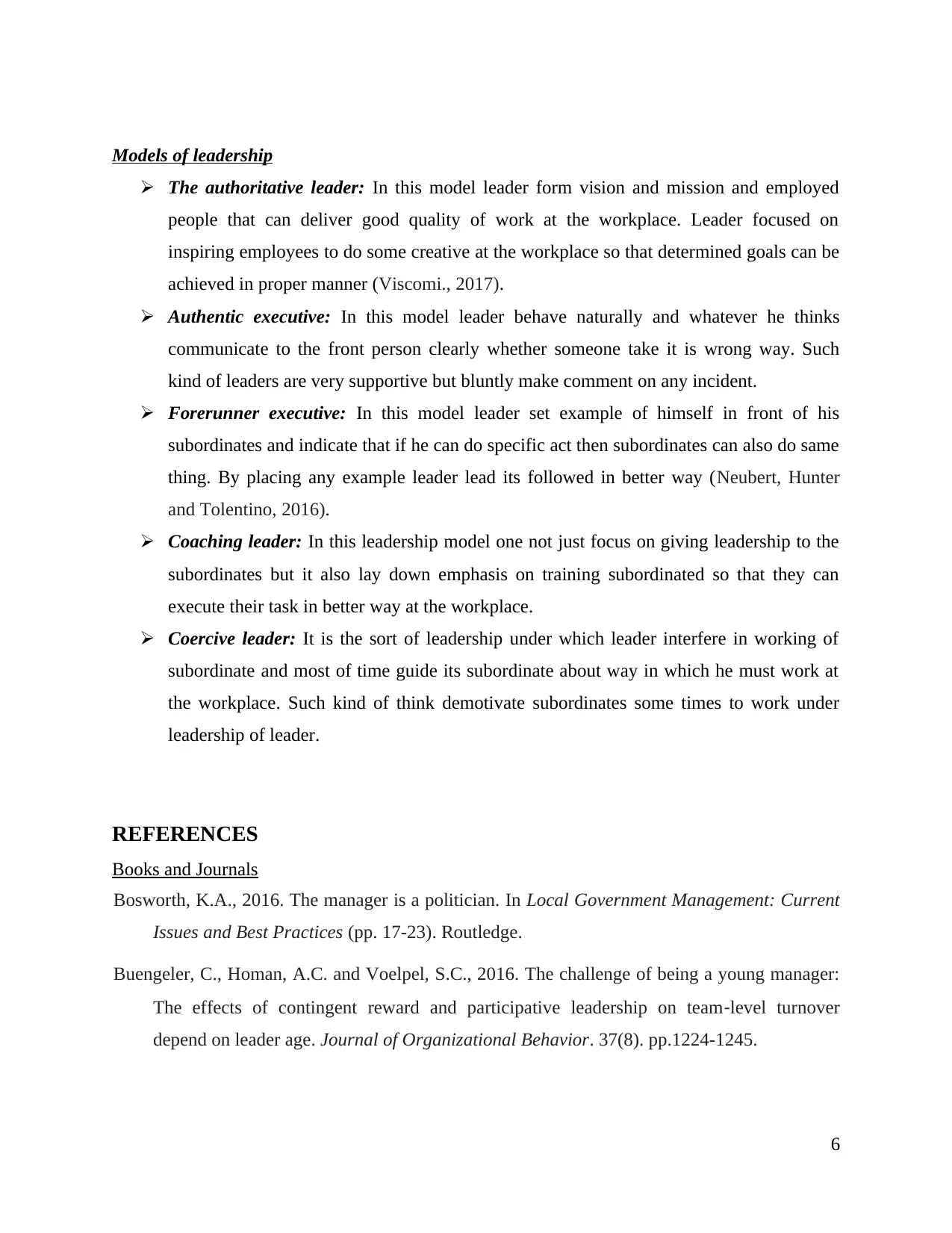
Models of leadership
The authoritative leader: In this model leader form vision and mission and employed
people that can deliver good quality of work at the workplace. Leader focused on
inspiring employees to do some creative at the workplace so that determined goals can be
achieved in proper manner (Viscomi., 2017).
Authentic executive: In this model leader behave naturally and whatever he thinks
communicate to the front person clearly whether someone take it is wrong way. Such
kind of leaders are very supportive but bluntly make comment on any incident.
Forerunner executive: In this model leader set example of himself in front of his
subordinates and indicate that if he can do specific act then subordinates can also do same
thing. By placing any example leader lead its followed in better way (Neubert, Hunter
and Tolentino, 2016).
Coaching leader: In this leadership model one not just focus on giving leadership to the
subordinates but it also lay down emphasis on training subordinated so that they can
execute their task in better way at the workplace.
Coercive leader: It is the sort of leadership under which leader interfere in working of
subordinate and most of time guide its subordinate about way in which he must work at
the workplace. Such kind of think demotivate subordinates some times to work under
leadership of leader.
REFERENCES
Books and Journals
Bosworth, K.A., 2016. The manager is a politician. In Local Government Management: Current
Issues and Best Practices (pp. 17-23). Routledge.
Buengeler, C., Homan, A.C. and Voelpel, S.C., 2016. The challenge of being a young manager:
The effects of contingent reward and participative leadership on team‐level turnover
depend on leader age. Journal of Organizational Behavior. 37(8). pp.1224-1245.
6
The authoritative leader: In this model leader form vision and mission and employed
people that can deliver good quality of work at the workplace. Leader focused on
inspiring employees to do some creative at the workplace so that determined goals can be
achieved in proper manner (Viscomi., 2017).
Authentic executive: In this model leader behave naturally and whatever he thinks
communicate to the front person clearly whether someone take it is wrong way. Such
kind of leaders are very supportive but bluntly make comment on any incident.
Forerunner executive: In this model leader set example of himself in front of his
subordinates and indicate that if he can do specific act then subordinates can also do same
thing. By placing any example leader lead its followed in better way (Neubert, Hunter
and Tolentino, 2016).
Coaching leader: In this leadership model one not just focus on giving leadership to the
subordinates but it also lay down emphasis on training subordinated so that they can
execute their task in better way at the workplace.
Coercive leader: It is the sort of leadership under which leader interfere in working of
subordinate and most of time guide its subordinate about way in which he must work at
the workplace. Such kind of think demotivate subordinates some times to work under
leadership of leader.
REFERENCES
Books and Journals
Bosworth, K.A., 2016. The manager is a politician. In Local Government Management: Current
Issues and Best Practices (pp. 17-23). Routledge.
Buengeler, C., Homan, A.C. and Voelpel, S.C., 2016. The challenge of being a young manager:
The effects of contingent reward and participative leadership on team‐level turnover
depend on leader age. Journal of Organizational Behavior. 37(8). pp.1224-1245.
6
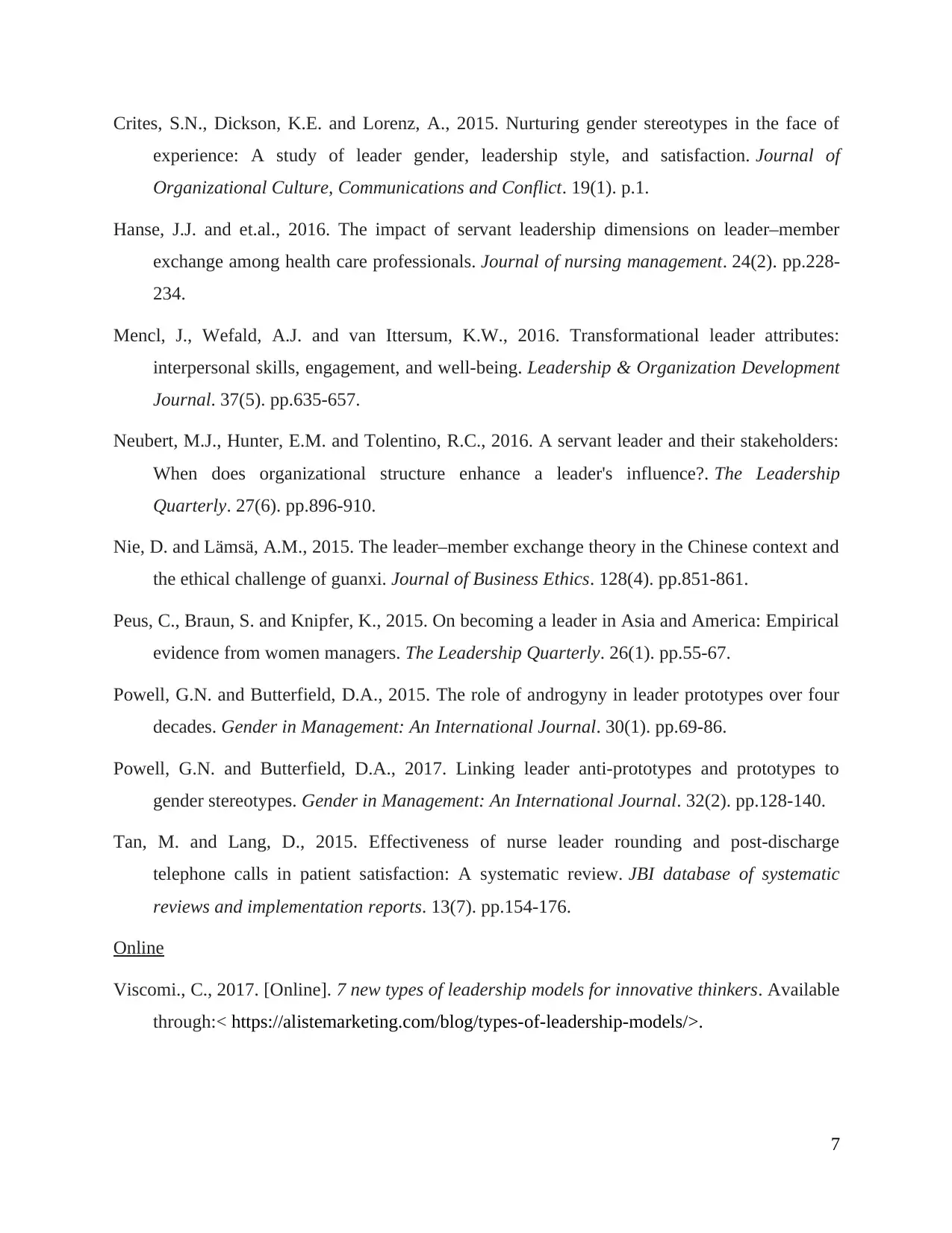
Crites, S.N., Dickson, K.E. and Lorenz, A., 2015. Nurturing gender stereotypes in the face of
experience: A study of leader gender, leadership style, and satisfaction. Journal of
Organizational Culture, Communications and Conflict. 19(1). p.1.
Hanse, J.J. and et.al., 2016. The impact of servant leadership dimensions on leader–member
exchange among health care professionals. Journal of nursing management. 24(2). pp.228-
234.
Mencl, J., Wefald, A.J. and van Ittersum, K.W., 2016. Transformational leader attributes:
interpersonal skills, engagement, and well-being. Leadership & Organization Development
Journal. 37(5). pp.635-657.
Neubert, M.J., Hunter, E.M. and Tolentino, R.C., 2016. A servant leader and their stakeholders:
When does organizational structure enhance a leader's influence?. The Leadership
Quarterly. 27(6). pp.896-910.
Nie, D. and Lämsä, A.M., 2015. The leader–member exchange theory in the Chinese context and
the ethical challenge of guanxi. Journal of Business Ethics. 128(4). pp.851-861.
Peus, C., Braun, S. and Knipfer, K., 2015. On becoming a leader in Asia and America: Empirical
evidence from women managers. The Leadership Quarterly. 26(1). pp.55-67.
Powell, G.N. and Butterfield, D.A., 2015. The role of androgyny in leader prototypes over four
decades. Gender in Management: An International Journal. 30(1). pp.69-86.
Powell, G.N. and Butterfield, D.A., 2017. Linking leader anti-prototypes and prototypes to
gender stereotypes. Gender in Management: An International Journal. 32(2). pp.128-140.
Tan, M. and Lang, D., 2015. Effectiveness of nurse leader rounding and post-discharge
telephone calls in patient satisfaction: A systematic review. JBI database of systematic
reviews and implementation reports. 13(7). pp.154-176.
Online
Viscomi., C., 2017. [Online]. 7 new types of leadership models for innovative thinkers. Available
through:< https://alistemarketing.com/blog/types-of-leadership-models/>.
7
experience: A study of leader gender, leadership style, and satisfaction. Journal of
Organizational Culture, Communications and Conflict. 19(1). p.1.
Hanse, J.J. and et.al., 2016. The impact of servant leadership dimensions on leader–member
exchange among health care professionals. Journal of nursing management. 24(2). pp.228-
234.
Mencl, J., Wefald, A.J. and van Ittersum, K.W., 2016. Transformational leader attributes:
interpersonal skills, engagement, and well-being. Leadership & Organization Development
Journal. 37(5). pp.635-657.
Neubert, M.J., Hunter, E.M. and Tolentino, R.C., 2016. A servant leader and their stakeholders:
When does organizational structure enhance a leader's influence?. The Leadership
Quarterly. 27(6). pp.896-910.
Nie, D. and Lämsä, A.M., 2015. The leader–member exchange theory in the Chinese context and
the ethical challenge of guanxi. Journal of Business Ethics. 128(4). pp.851-861.
Peus, C., Braun, S. and Knipfer, K., 2015. On becoming a leader in Asia and America: Empirical
evidence from women managers. The Leadership Quarterly. 26(1). pp.55-67.
Powell, G.N. and Butterfield, D.A., 2015. The role of androgyny in leader prototypes over four
decades. Gender in Management: An International Journal. 30(1). pp.69-86.
Powell, G.N. and Butterfield, D.A., 2017. Linking leader anti-prototypes and prototypes to
gender stereotypes. Gender in Management: An International Journal. 32(2). pp.128-140.
Tan, M. and Lang, D., 2015. Effectiveness of nurse leader rounding and post-discharge
telephone calls in patient satisfaction: A systematic review. JBI database of systematic
reviews and implementation reports. 13(7). pp.154-176.
Online
Viscomi., C., 2017. [Online]. 7 new types of leadership models for innovative thinkers. Available
through:< https://alistemarketing.com/blog/types-of-leadership-models/>.
7
⊘ This is a preview!⊘
Do you want full access?
Subscribe today to unlock all pages.

Trusted by 1+ million students worldwide
1 out of 9
Related Documents
Your All-in-One AI-Powered Toolkit for Academic Success.
+13062052269
info@desklib.com
Available 24*7 on WhatsApp / Email
![[object Object]](/_next/static/media/star-bottom.7253800d.svg)
Unlock your academic potential
Copyright © 2020–2025 A2Z Services. All Rights Reserved. Developed and managed by ZUCOL.




